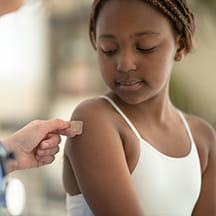Despite multiple trips to the doctor, the source of little Fredrik’s chronic illness remained a mystery. It wasn’t until after a prolonged stay at Connecticut Children's that his family discovered the culprit — their home was making the child sick.
The care team at Connecticut Children’s referred the family to the hospital’s Healthy Homes program, an initiative aimed at improving health outcomes for children by enhancing the quality, stability, and affordability of their homes. Upon visiting the family’s home, the Healthy Homes team identified a leaky basement that could be causing asthma-inducing mold. Additionally, they discovered lead paint throughout the house. With the program’s funding, Healthy Homes arranged for contractors to install a drainage system in the basement, remove all lead paint, and repaint all affected surfaces. Since the remediation, the family reports that Fredrik’s asthma symptoms have improved.
Making houses healthier
Fredrik’s is one of more than 3,000 homes made safer for children by Healthy Homes. Connecticut Children’s launched the program in 2003 primarily to address lead hazards in the region. The program expanded in 2015 to include additional health concerns, such as asthma, radon, and safety-related injuries. Families may contact Healthy Homes directly for a home assessment, but most are referred to the program following routine checkups with a child’s medical provider, by local health departments who monitor children’s lead blood levels, or after home visits by social workers.
Healthy Homes outreach staff have specialized training in lead mitigation and in assessing environmental hazards, enabling them to identify health risks during home assessments. If remediation is needed, Healthy Homes develops a scope of work and coordinates with approved contractors who remedy the problems.
Families don’t pay for the assessment or mitigation work. The work is funded by Connecticut Children’s Office for Community Child Health (the Office), as well as by grants from the U.S. Department of Housing and Urban Development (HUD), and the Connecticut Department of Housing, and the Connecticut Department of Public Health. Healthy Homes is one of 17 programs within Connecticut Children’s Office for Community Child Health, which is committed to developing comprehensive systems that provide families with access to community-based programs, resources, and services aimed at promoting the optimal healthy development of children.
Steps to making families’ homes healthier
Healthy Homes has expanded its influence over the last two decades by integrating with like-minded initiatives both internally and throughout the community. The model can be replicated elsewhere, according to Chris Corcoran, the program’s manager.
In a Children’s Hospital Association webinar, Corcoran identified several steps children’s hospitals can take to ensure healthier homes in their own communities.
- Survey patients. In addition to medical questions, medical practitioners should inquire about patients’ housing during clinical visits. Does the heat work? How is the cleanliness? But beyond inquiring, it’s important staff know where to direct patients to address reported deficiencies. Corcoran recommends creating a resource guide for team members with a directory of hospital and community-based contacts for families who need assistance.
- Educate internally. While Connecticut Children’s continues to build external partnerships to grow its services, the hospital hasn’t lost sight of cultivating relationships within its walls. “It’s also about collaborating and getting synergy among our own programs,” Corcoran said. “If I’m going into a unit and learn about the needs of someone related to the Injury Prevention Center, for example, I know I can bring them in.”
- Create a coalition. There’s a good chance other providers and institutions in your area have similar goals. A collaboration can accomplish more than multiple individual efforts, but it may require someone to get the ball rolling.
- Be the hub. To that end, a children’s hospital is well-positioned to pull together organizations from health care, social services, governmental agencies, contractors, and more. Corcoran said as Healthy Homes expanded, Connecticut Children’s has often functioned as a conduit for multi-disciplinary partnerships.
- Cast a wide net. “Don’t be narrow about who you think is going to be the right partner,” Corcoran said. “Any organization that has someone going into homes or has interactions with families can be a viable partner.”
- Seek governmental help. Leverage existing programs at the state and local levels that aid those with substandard housing arrangements. Additionally, Corcoran said enlisting the assistance of state legislators and municipal leaders can boost your program’s efforts.
- Follow established programs. Using a blueprint that’s already proven successful is the quickest—and easiest—way to affect meaningful change in your community. “We’re developing programs that can be replicated, so we’re happy to share any resources we have to help guide other programs to do something similar where they are working,” Corcoran said.



